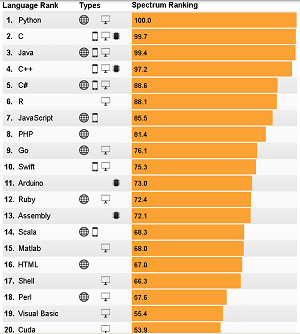News
Python Tops IEEE Spectrum Programming Language Ranking
- By David Ramel
- July 24, 2017
Python, known for its simplicity and developer-friendliness, has slithered to No. 1 on the new IEEE Spectrum ranking of top programming languages for 2017.
The open source, interpreted, object-oriented language has been on a roll lately, having just been named the No. 1 dev tool of any type in a survey conducted by Packt Publishing.
And last month, the RedMonk Programming Language Rankings listed it as No. 3, behind only JavaScript and Java. It also has been growing in popularity in other studies, including the March Stack Overflow Developer Survey.
Now it tops the IEEE Spectrum "The 2017 Top Programming Languages" ranking, which differs from other similar indices in its methodology and ability to provide interactive orderings based on user weighting.
In the fourth such study, IEEE Spectrum -- a magazine associated with the organization that used to be generally called the Institute of Electrical and Electronics Engineers -- places it ahead of C, Java, C++ and C# in the default ranking designed for the typical reader.
The ranking is determined by a complicated process developed by data mining journalist Nick Diakopoulos.
 [Click on image for larger view.]
The Top 20 (Default Ranking) (source: IEEE Spectrum)
[Click on image for larger view.]
The Top 20 (Default Ranking) (source: IEEE Spectrum)
"Python has continued its upward trajectory from last year and jumped two places to the No. 1 slot, though the top four -- Python, C, Java, and C++ -- all remain very close in popularity," the publication said in a
post last week. "Indeed, in Diakopoulos's analysis of what the underlying metrics have to say about the languages currently in demand by recruiting companies, C comes out ahead of Python by a good margin."
Indeed, while Python ranks first in the default, trending and open source interactive rankings, it comes in No. 3 behind Java and C in the jobs ranking (languages that are in demand by employers). The IEEE Spectrum tool also lets users create their own customized ranking and features filtered categories (Web, Mobile, Enterprise and Embedded) to further hone the results.
Several commenters on the IEEE Spectrum post debated Python's usage in areas other than academia. While one reader questioned if it's ever used outside the hallowed halls of educational institutions, many other readers chimed in with affirmative real-world use cases.
"Many people use Python outside of academic purposes..." one reader commented. "The popularity of Python Web frameworks such as Django, Flask, etc. can't be denied. Python is also popular in the field of scientific data analysis and it is widely used in IT infrastructure automation/scripting."
While its use cases seem to be expanding, so has its ranking on the IEEE Spectrum tool been rising, as it has been climbing steadily among the mostly stable group of top-rated languages that dominate the listing each year.
For example, in last year's IEEE Spectrum ranking, Python was No. 3 behind C and Java, ahead of C++ and R.
In the 2015 report, Python was No. 4, behind Java, C and C++ and ahead of C#.
The 2014 ranking had the same top five as 2015.
About the Author
David Ramel is an editor and writer at Converge 360.